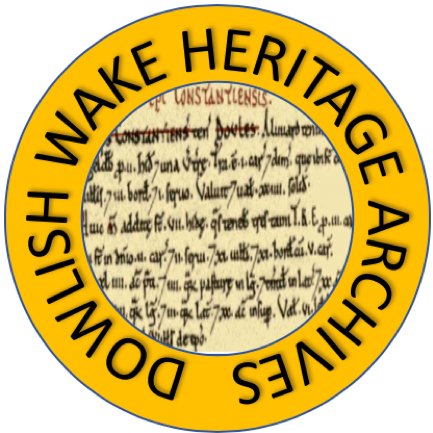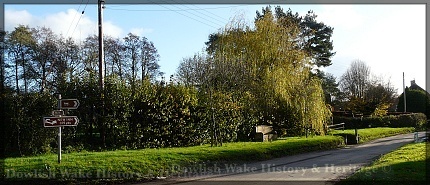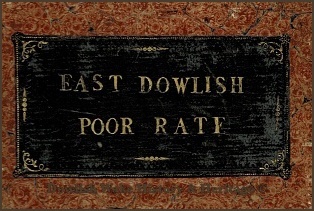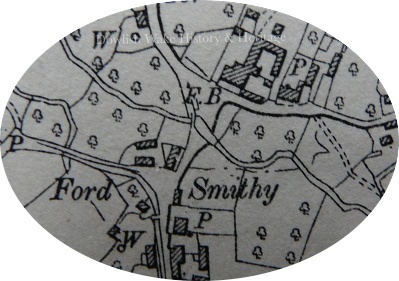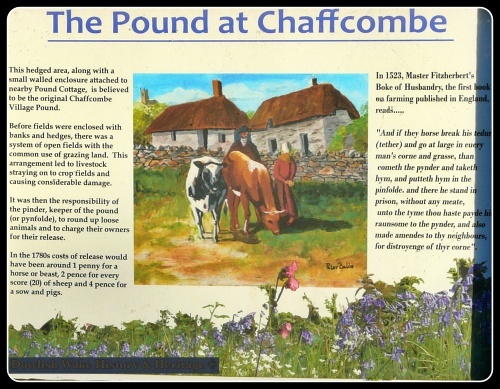Village Pound - 1830s.
- The pound was an enclosure used to in-pound stray animals. Maybe a simple stock-proof hedge, post & rail fence or built of stone.
- Medieval open-field systems called for some method of
dealing with stray animals. It seems that Dowlish had at one time a pound near the village green. This topic introduces the use of a tally-stick, a simple method of recording details between the parties involved and fines paid.
- There is no living memory of a Dowlish village 'pound', but village archives do indeed suggest that at one time such an enclosure existed in the village. In the 1837 East Dowlish Poor Rate Book, there is a handwritten
entry, within in its listing of properties, of an orchard by the Packhorse Bridge. It reads; Plot 40, Orchard [by the pound]. 1838 Tithe Apportionments online records, for East Dowlish show both the entry and the map. The Orchard is situated near the Packhorse Bridge.
The Tithe apportionments of East Dowlish identify; owners, tenants, properties and fields. The map illustrates the whereabouts of each plot. Plots were measured [acres, rods and perches] and numbered. Joseph Duke in 1837 the occupier/tenant of plot 40, with Thomas Shute, the owner. Ten years later Joseph Duke still the occupier, but William Speke, the owner. Tithes were raised providing support for the church, clergy and the parish. Before 1836 tithes were paid in kind, grain or other harvested produce. After 1836 there was a move to monetary payments, a tithe rent charge.
The location of the pound is vague, and so is it’s Pound Keeper [Pinder/ Impounder]. He or she might benefit some income from this, first having retrieved the animal from the owner/tenant of the land on to which it had strayed. Having captured, secured and driven the animal/animals [cows/sheep/pigs/horses or geese] to the pound, he would feed and water as necessary. The animal owner would be expected to reimburse the landowner on which the animals had strayed, and the impounder for his trouble in caring for the animal/animals. The village gamekeeper/bailiff of Keepers Cottage in Mill Lane may have been the Pound Keeper. Or maybe one of the village farmers or his men.
The animals' welfare was brought to the fore by eventual legislation, a bill by M.P. Richard Martin, who had famously brought a donkey into a courtroom. An Act known as ‘Martins Act’, came into being in 1822. Initially worded more for cattle, a subsequent act in 1835 mentioned impounding of animals, to include Horse, Mare, Gelding, Bull, Ox, Cow, Heifer, Steer, Calf, Mule, Ass, sheep, or lamb or any other cattle or domestic animals. The act allowed for unclaimed animals to be sold after seven days at a local market, having given three days public printed notice of intention. Thereby recovering expenses. Additionally, there was an allowance for any person or persons, without fear of trespass, to enter the ‘common pound/openpound/closepound’ or any other enclosure to supply said animals with food and water.
An interesting version of how monies exchanged hands was the use of a Tally-Stick. Used since medieval times as a record of exchanges of goods and payment. A split stick with its two halves unique to each other. In our case, the landowner that was seeking recompense would choose a stick, cut it to length, mark notches into it for each animal strayed, then split the stick with each half showing the notches. He would give one to the Pound Keeper/Tallyman and retain the other himself. The rightful owner of the animal would pay his debt to the landowner who handed over the half stick. This was taken to the village Pound-Keeper who released the animals on payment of his fee and the successful matching of both notches on both halves of the Tally-Stick.
It's possible that during any year there may have been several animals straying, possibly with damage caused. Dowlish had several farms whose animals might stray. Not forgetting the possibility of sheep escaping the sheep dipping. Furthermore, the potential for straying animals would have occurred with drovers/farmers, on route to local stock markets and ancient fairs. Ilminster had had a charter for a fair since the year 1086. John Symes Cuff, 
Transport for animals was mostly on foot in villages of old. For instance; Ilminster had a Tollfree market, cattle in West Street, and Court Barton for sheep and pigs in the 1830s. On market day local farmers might have their labourers herd a dozen or more cattle up into town to be penned awaiting the auctioneer. Ilminster would have looked a very different town in the past with drovers arriving and departing to and from distant towns. The advertisement of such markets published in other counties newspapers.
Animals straying on public highways would be taken to the nearest pound. Drovers of cattle were cautioned in 1815 as to the problems of entering ‘populous places’ following an accident with an ‘over-driven’ cow. A lady was knocked down in Union Street, Bath, she was badly bruised by the animal which was running furiously down several streets causing ‘the greatest alarm’.
On occasions, straying animals were the subject brought to law. A newspaper article headed ‘The law of Impounding” is one such example. In June 1892, 18 cows belonging to Mr Samuel Baker, Sea farm, Ilminster strayed into crops of wheat and mangolds in fields owned by Mr White of Moolham Farm. At Ilminster Petty Sessions the charge was heard; Mr Baker had illegally released a cow from the pound and broken the lock. The cows had been impounded in Mr Whites barton [farmyard], he subsequently releasing 17 of the cows, but keeping one and locking it up. Sometime later that morning Mr White found the lock was broken and the cow was gone. In court much ado continued as verbal claims were voiced; crop damage, wheat £3, mangolds 30 shillings plus damage to lock. The other party was arguing the suffering of his prize cow who was ‘in dire need of milking’ plus denying the breaking of the lock, claiming he had simply unhung the gate. Intervening, the Justices suggested that the parties settle the matter between themselves, but no agreement could be reached. Mr Baker said that not a bushel of damage had been caused to the wheat and as for the mangolds, 'it did them some good', this last remark to much laughter. The Chairman concluded the affair by telling Mr Baker to pay £1, and Mr White must get his damages elsewhere.
Earlier in 1835 ‘Breaking the Pinfold’ brought imprisonment for an offender. A charge was given at local Quarter Sessions in York; Impounded animals had been released unlawfully by the prisoner. The case in Ampleforth, held in the year 1835 at York, saw a Richard Spence found guilty. His two asses had been impounded after they were found in a wheat field belonging to a Mr Jermaine. It had taken the Impounder several hours and attempts to capture the animals. Witness saw the prisoner, who had a wooden leg, break the gate of the pinfold, release and drive away the two asses. He was found guilty, imprisoned for three weeks and fined 1 shilling.
Around Britain, few stone/brick-built pounds have survived otherwise the odd road or cottage name, such as Pound lane/cottage reflects a former pound. Donyatt has its ‘Pound Cottages’. Searching Somerset Heritage website and their online catalogue, we see a 1795 reference to Ilminster having a Pound on Strawberry Bank. Historic England, have a listed building category for a village pound on the west side boundary of the churchyard at Seavington St Michael. Just what they looked like and how they were formed we can look to newspaper Archives. In the section ‘Notes and Queries’, ‘The Courier’, 1935 we have a reader remembering Somerset village pounds. Of the Donyatt Pound, he writes “ nothing now but a heap of stones”. Of Ilton, he writes ‘It stood halfway down the road leading towards the Post Office and Cad road. It consisted of a high, square fence, painted black but was demolished about 30 years ago”. Broadway, he writes “marked by a low wall” and of Ashill, by the Ashill Inn, “it’s used now for storing firewood”.
Dowlish no longer has its village pound or its farm labourers herding their stock on foot to market in early mornings. Interestingly though, we can view a 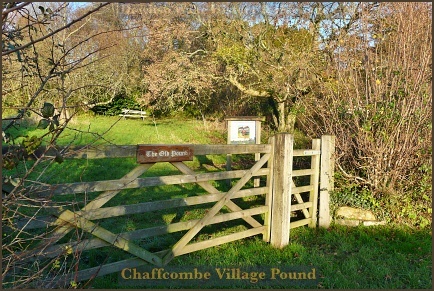
Sources and useful links:
The word ‘Pound’ typical in the South, while in the North more commonly Pinfold or Pynfolde.
The term of old English origin ‘Pund’ meaning an enclosure.
East Dowlish Rate Book-Dowlish Wake Heritage & History. An Account of the Tithes Lands and Tenements in the Parish of East Dowlish, and their several occupiers and owners in the year 1837 with a rate of 10d in the £. The Orchard has its measurement recorded as 2 Rods/Roods. With a value of £1 and 3 shillings.
Tithe Apportionments and Tithe maps. Somerset Record Office & online subscription site www.genealogist.co.uk
Measurements – www.nottingham.ac.uk see Manuscripts and Special Collections - Measurements
Somerset Heritage Centre. Somerset Archive Catalogue. Ilminster, Whitelackington, etc. deeds. 1724-1835. Ref DD/CA/2 [Ilminster Pound].
Historic England. Listed Building Entry No 1057003 [Village Pound, churchyard. Church of St Michael]. John Symes Cuff. [The original document is at Somerset archive centre in Taunton. Catalogue no A/AGB/1. The entry reads [Wilsons] diary, possibly belonging to a farm in Chard/Ilminster area 1858.]
Martins Act. ‘Act to prevent the cruel and improper treatment of Cattle’. wikipedia.org
Breaking the Pinfold. York Herald, 18 April 1835. Online subscription website, British Newspaper Archives, findmypast.co.uk 1835 Legislation. 1835: 5&6 William 4 c.59: Cruelty to Animals Act. Statutes.org.uk
Samuel Baker v Mr White. The Chard and Ilminster News, 2 July 1892 Online subscription website, British Newspaper Archives, findmypast.co.uk.
Ilton, Broadway, Donyatt and Ashill Village Pounds. The Courier, 3 April 1835. Notes and Queries No 2611. ‘Replies to Queries’. Online subscription website, British Newspaper Archives, findmypast.co.uk
Ilminster Cattle Market. Dorset County Chronicle 16 May, 1833 Online subscription website, British Newspaper Archives, findmypast.co.uk Bath drovers of cattle. The Salisbury and Winchester Journal 12 June 1815. Online subscription website, British Newspaper Archives, findmypast.co.uk
Worth a read and a listen to the accompanying song. A popular Music Hall song in its day. See Website ‘jonwilks.online’ The Trial of Bill Burn under Martin’s Act- The Story of the Song & Video ‘The Trial of Bill Burn Under Martin’s Act – Roud Broadside B24869…’
Chaffcombe Village Pound. See website www.chaffcombe.com Tithe Apportionments Online subscription website, www.genealogist.co.uk Ordnance Survey Map – Second Edition 1904 – Somerset sheet LXXXVIII. N.W. www.wikipedia.org/wiki/Animal_pound wikipedia.org/wike/Tally_stick
www.geographic.org.uk/tagged/Village+Pound
www.britishhistory.ac.uk Fairs in England and Wales to 1516
A painting of the trial of Bill Burns - The prosecution was brought by MP Richard Martin, also known as "Humanity Dick". Burns was found beating his donkey. Source-" The Cruel Treatment of Cattle Act 1822". Wikipedia. wikipedia.org/Wiki/Richard Martin [Irish Politician] CC BY-SA 3.0. https: en.m.wikipedia.org
